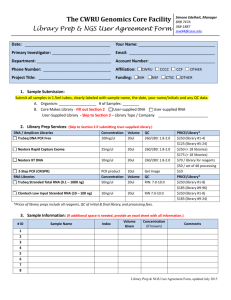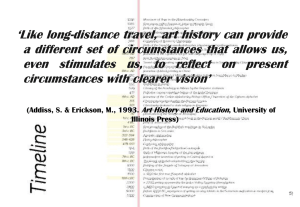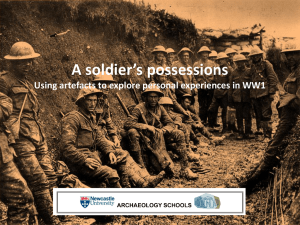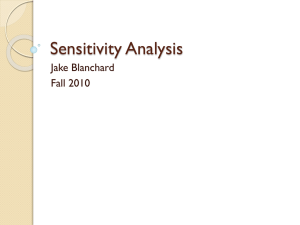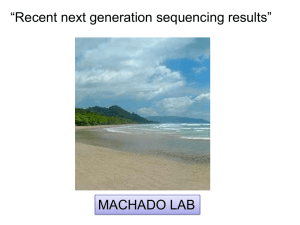The challenges of sequencing FFPEDNA using NGS
advertisement
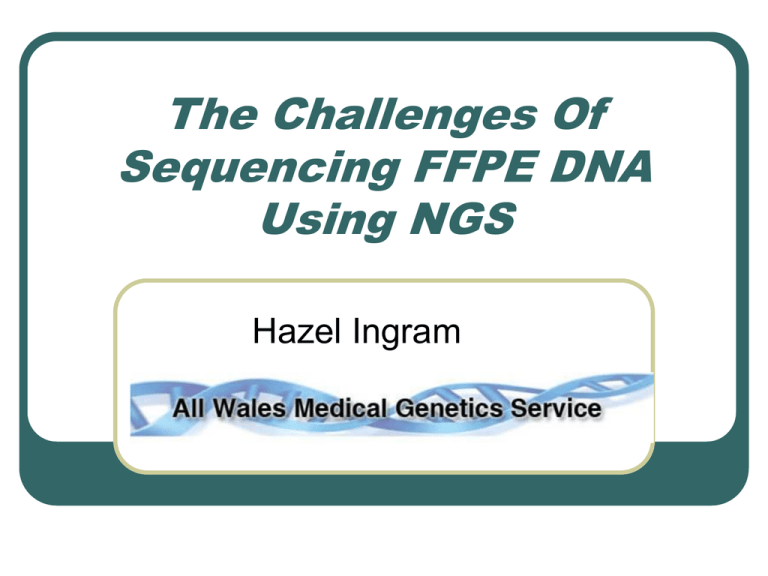
The Challenges Of Sequencing FFPE DNA Using NGS Hazel Ingram Problems with FFPE Poor quality/fragmented DNA Fixation artefacts Insufficient tumour material Low tumour content Measuring Quality • Nanodrop vs Qubit • Fragmentation Projects CRUK SMP1 FOCUS 4 WCB Sample Duplicate Single Single Library Prep TSCA TSCA Haloplex Sequencing MiSeq MiSeq MiSeq Analysis MiSeq Reporter NextGENe NextGENe 5% sensitivity 5% sensitivity 150x coverage 50x coverage HGMD – custom pipeline Thresholds for 5% sensitivity variant 150x coverage per calling replicate Validation Determine acceptable coverage for regions of interest To match or increase sensitivity compared to original methods (pyro and sanger) Low level of false positives Must have at least 90% concordance CRUK SMP1 Validation Overview Illumina validation: • 42 samples sent: • • • In House validation: • 45 samples • • • 37/42 matched (88%) 3/42 non concordant • low coverage 2/42 non concordant • design issue Artefacts Low Coverage Technological Design Higher Sensitivity of NGS 43 matched (95%) 2/45 • low coverage Overall, between hubs 18 extra variants previously undetected in 124 samples • Technological fail of pyro/sanger • Higher sensitivity of NGS Large number of artefacts detected Failure rate: approx 10% Artefacts Duplicate Testing Solution = testing of each sample in duplicate Sequencing artefacts only seen in 1 replicate True variants seen in both replicates Pipeline - only sequence variants observed in both replicates retained for analysis Strategy Average number of variants per sample Range in number of variants per sample Singlicate testing 113 3-546 Duplicate testing 30 0-60 * Duplication used for CRUK panel only Artefacts - Sanger Seq False Positive (deamination) KIT c.1745G>A p.Trp582X – CRUK SMP Mutation not detected by NGS (single testing: >4000x) Mean coverage across panel: 4840x KIT re-tested by Sanger…no mutation detected C>T deamination artefact caused by formalin fixation …duplicate testing solves this issue UDG treatment prior to PCR may help removes uracil lesions by hydrolysing N-glycosidic bond Minimum Coverage: CRUK & FOCUS4 Known variants became undetectable when coverage for region of interest <150x 150x minimum coverage cut-off implemented • For CRUK: <150x coverage in either replicate = failed exon • Avoided reporting false negative results • Failure rates were still comparable to original testing Design CRUK (TSCA) • PTEN 27bp del missed • Deletion removed probe binding site FOCUS4 (TSCA) • NRAS c.182A>G p.Q61R • Region had zero reads poor amplification WCB (Haloplex) • PIK3CA ex9 c.1634A>G, p.E545G missed Library Prep Methods: TSCA vs Haloplex Both panels designed to cover same ROI Same samples run on both panels Run on MiSeq and analysed using NextGENe for direct comparison Number of samples Number of expected mutations Number of mutations found Percentage Haloplex – NextGENe 11 28 28 100% TSCA NextGENe 11 28 26 93% TSCA vs Haloplex Projects CRUK SMP FOCUS 4 WCB Sample Duplicate Single Single Library Prep TSCA TSCA Haloplex Sequencing MiSeq MiSeq MiSeq Analysis MiSeq Reporter NextGENe NextGENe 5% sensitivity 5% sensitivity 150x coverage 50x coverage HGMD – custom pipeline Thresholds for 5% sensitivity variant 150x coverage per calling duplicate Conclusions and Future Work DNA quality from FFPE tissue is a major challenge Help interpretation by: • • Running in duplicate being careful with assay design and minimum coverage Additional steps e.g. UDG treatment can help minimise deamination artefacts Need a more robust NGS technology for low quality DNA from FFPE • Alternative NGS platforms / providers • Alternative enrichment methods e.g. target capture as alternative to PCR based Acknowledgements Alex Stretton James Eden Helen Roberts Rachel Butler Matt Mort (HGMD) The All Wales Medical Genetics Service Hazel.ingram@wales.nhs.uk
